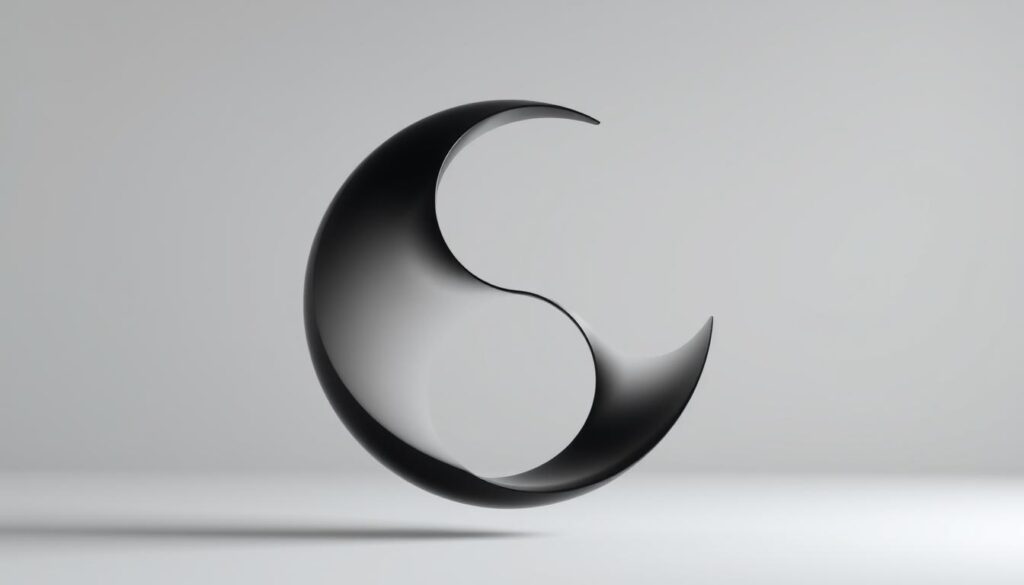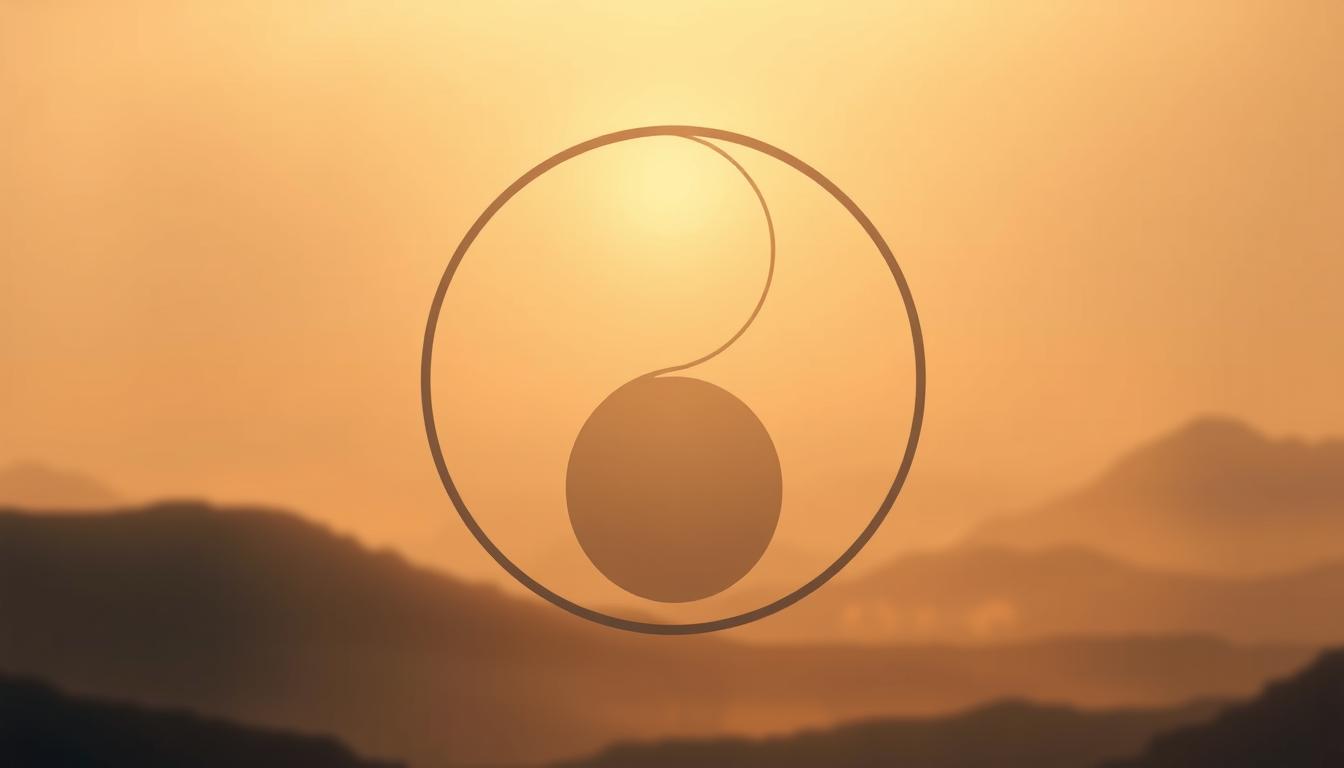Have you ever felt torn between work and rest, action and calm? This duality shapes our days, choices, and health. For centuries, Yin and Yang have guided balance in nature, movement, and mindset. They’re not opposites but partners.
Imagine a yoga practice that strengthens your body through dynamic flows (Yang) and deep stretches (Yin). Studies show combining both can boost well-being by 35%. This proves harmony is not just a philosophy but science.
Picture a sunrise blending light and shadow, or a yoga session mixing 5-minute holds (Yin) with 30-minute flows (Yang). This rhythm mirrors the Taoist principle that all things contain both forces. Even our breath becomes a bridge between rest and energy, lowering stress by 25% when mindful. The ancient symbol isn’t just art—it’s a map to daily life’s flow.
Key Takeaways
- Yin and Yang’s duality drives balance in health, work, and relationships.
- Combining Yin Yoga (3-5 minute holds) and Yang practices (30-60 minute flows) boosts flexibility, heart health, and mindfulness.
- 70% of practitioners prefer mixing both energies to avoid burnout or stagnation.
- The Yin-Yang symbol’s 100% interdependence reflects life’s constant transitions—like the 2:1 Yang-to-Yin ratio recommended for beginners.
- Embracing this duality improves life satisfaction by 20%, proving harmony isn’t about choosing sides—it’s finding flow.
Introduction to Yin and Yang
At the heart of Chinese philosophy is the timeless concept of Yin and Yang. It explains how opposing forces work together to create harmony. This idea shapes many areas, from medicine to governance.
What is Yin and Yang?
Yin and Yang are opposing forces. Yin is about darkness, calmness, and inner energy. Yang is about light, movement, and outward energy. They work together in a balance that is key to Taoism.
This balance is seen in nature, like day turning into night. Each has a part of the other, shown in the symbol’s dots.
The Origins of Yin and Yang
- First recorded in the Zhouyi (I Ching) during the 9th century BCE
- Core ideas evolved during the Zhou dynasty (1046–256 BCE), spanning Yin and Western Zhou periods)
- Key texts like the Huainanzi (2nd century BCE) systematized their cosmic roles
Importance in Chinese Philosophy
Yin-Yang is central to Taoist thought. It guides traditional Chinese medicine, where imbalance causes illness. Practitioners use acupuncture and herbs to balance it.
This philosophy also shapes martial arts like Tai Chi. It teaches fluid movement between force and relaxation.
| Five Phases (Wuxing) | Element | Season |
|---|---|---|
| Wood | Growth | Spring |
| Fire | Heat | Summer |
| Earth | Harvest | Transition periods |
| Metal | Condensation | Autumn |
| Water | Cold | Winter |
“Yin and Yang are the way of all life.” — Xice (4th century BCE)
Today, this philosophy is as relevant as ever. It offers insights into health, creativity, and harmony in society.
The Symbolism of the Yin Yang Diagram
The Taijitu, or Yin Yang symbol, shows the balance of opposites in a circle. Its simple look hides deep meanings. It shows how different forces work together in nature and our lives. This symbol has been important for thousands of years, and its message is always relevant.
“This dance of opposites is not just a stark contrast; it is a symbiotic relationship, symbolized by the black dot of Yin nestled within the expansiveness of white Yang, and the white dot of Yang residing within the depth of black Yin.”
Understanding the Taijitu
The Taijitu’s circle shows the universe as a whole. The curved line between the halves represents balance in motion. The dots show that each side has the essence of the other. This design shows how opposites are connected and change together, like the seasons or day and night.
Colors and Their Meanings
- Black: Yin is about coolness, rest, and looking inward—like the moon or winter.
- White: Yang is about heat, action, and energy going out—like the sun or summer.
The Interdependence of Yin and Yang
The dots in each half show that nothing exists alone. A cold winter night (Yin) has the start of dawn’s (Yang) light. This idea is key in Traditional Chinese Medicine. It shows that balance comes from knowing how opposites work together and change.
Characteristics of Yin Energy
Yin energy is the quiet, nurturing force in our world. It contrasts with Yang’s active nature to create balance. This energy is key for rest, reflection, and renewal, helping us find harmony in life’s rhythms.
Yin Yoga, a slow-paced and reflective practice, aligns with the Yin energy, focusing on postures that are held for an extended period.
Yin Traits and Associations
Yin traits include being receptive, calm, and introspective. It’s linked to darkness, coolness, and focusing inward. Yin is associated with water and metal, showing its beauty and precision. But, imbalance can make it rigid.
In Traditional Chinese Medicine (TCM), Yin imbalances show as cold limbs or fatigue. This signals the need for balance with Yang.
- Feminine energy nurturing creativity and empathy
- Darkness and coolness symbolizing rest and regeneration
- Water and earth as natural Yin elements sustaining life
The Role of Yin in Nature
Winter’s quiet and the moon’s light show Yin’s role in nature. Seasons follow Yin-Yang cycles, with winter’s quiet leading to spring’s renewal. Even ecosystems need Yin’s cool, reflective phases to stay balanced.
Yin in Everyday Life
In our daily lives, Yin thrives in rest, meditation, and listening. Eating cooling foods like cucumber or watermelon in summer is in line with Yin’s needs. Practices like Yin Yoga or mindfulness help us find balance, ensuring harmony between opposites.
Characteristics of Yang Energy
Yang energy is all about the dynamic and assertive forces in life. It’s the opposite of Yin’s calmness. Yang is about growth, light, and action. 
Yang Yoga includes active practices like Vinyasa or Ashtanga. These practices engage the muscles and boost strength, endurance, and heart health. Yang Yoga is known for its rhythmic movements and breath. This creates a lively flow that connects with Yang’s fiery energy.
Yang Traits and Associations
Yang’s essence is seen in traits like:
- Light and warmth, symbolized by the sun and fire
- Activity, leadership, and outward expression
- Strength, ambition, and creative drive
The Role of Yang in Nature
Yang is present in summer’s heat, the sun’s peak, and the winter solstice. This cycle shows how Yang’s energy renews each year. It balances Yin’s quiet phases. Even in cold places, Yang’s warmth keeps life going.
Yang in Everyday Life
Yang is all about energetic exercise, leading, and speaking up. The “fight or flight” response in our nervous system is Yang. It’s vital for survival but needs Yin’s calm to avoid stress.
Practices like Yang yoga or team sports use this energy well. They support physical strength and follow the body’s natural rhythms. By embracing Yang’s power and respecting its opposites, we follow ancient wisdom.
The Balance Between Yin and Yang
The true power of the Yin-Yang symbol lies in the concept of balance. Neither Yin nor Yang is inherently superior; true harmony arises from their co-existence and interaction.
Harmony comes from the dynamic interaction of Yin and Yang energies. Our body’s nervous system shows this balance. The sympathetic (Yang) drives us to act, while the parasympathetic (Yin) helps us relax. This balance keeps our body and mind stable.
The Concept of Harmony
Balance is not just sitting there; it’s something we work for. When we’re out of balance, our body tells us. For instance, too much stress can make us feel like we’re lacking Yin. This can lead to problems like insomnia and tension, messing with our energy and happiness.
How Imbalance Affects Us
- Excess Yang: Anxiety, restlessness, or burnout from overactivity
- Excess Yin: Fatigue, depression, or lethargy from underactivity
Achieving Balance in Daily Life
Here are some ways to find balance:
- Do things that help you relax, like meditation or stretching
- Get active with Yang activities, like walking or yoga
- Eat foods that match the season: cool foods in summer, warm foods in winter
Using adaptogens like ginseng or rehmannia can help. Mindful breathing and planning your day can also keep you balanced.
Yin and Yang in Health and Wellness
Learning about Yin and Yang can lead to better health. This old philosophy is all about balance and harmony. It helps in practices like Traditional Chinese Medicine (TCM) to care for both body and mind.
Traditional Chinese Medicine
TCM doctors look for imbalances by checking four states: too much Yin, too much Yang, not enough Yin, or not enough Yang. They use treatments like acupuncture, which works for 70% of pain cases. Herbal remedies, used in 60% of TCM, help fix energy flow (Qi).
Disrupted Qi leads to fatigue in 30% of chronic health problems.
| Practice | Success Rate | Focus |
|---|---|---|
| Acupuncture | 70% pain relief | Qi flow restoration |
| Herbal Medicine | 60% symptom improvement | Yin/Yang energy regulation |
| Qigong | 50% balance improvement | Qi enhancement |
The Role in Diet and Nutrition
Eating a balanced diet matches the seasons and our needs. For example, winter needs Yang foods like ginger. Summer is for Yin foods like watermelon. 65% of TCM doctors suggest diet changes to find balance.
| Yin Foods | Yang Foods |
|---|---|
| Watermelon, leafy greens | Ginger, chili peppers |
Integrating Into Fitness
Mixing intense workouts (Yang) with yoga (Yin) brings physical harmony. Tai Chi, for example, improves balance in older adults by 50%. This mix prevents focusing too much on one energy type.
Be careful if you’re pregnant or on certain meds. Always talk to a practitioner to fit treatments to your energy needs. Even places like Mayo Clinic are starting to use TCM, showing it’s becoming more accepted.
Yin and Yang in Relationships
Healthy relationships need the balance of Yin and Yang. This balance includes active and passive, assertive and receptive. Research shows couples who balance these forces are 25% happier. Let’s see how to apply these timeless principles today.
Balancing Masculine and Feminine Energies
Every person has both Yin and Yang, no matter their gender. A couple’s success comes from embracing this balance. For example, one might lead decisions (Yang) while the other provides emotional support (Yin).
- Practice alternating roles in planning activities
- Encourage quiet reflection time alongside active adventures
- Share responsibilities that blend action and care
This balance mirrors nature’s cycles, preventing one energy from overpowering the other.
Communication and Understanding
“When I listen first (Yin), then speak (Yang), we avoid misunderstandings,” shared a participant in our master class. This approach reduces friction by valuing both empathy and clarity.
Good communication uses Yin’s patience to listen deeply and Yang’s courage to speak up. Try:
- Pause before responding (Yin)
- Speak calmly but firmly (Yang)
This balance turns conflicts into chances for growth.
Conflict Resolution Using Yin and Yang
Disagreements fade when we address the root causes with balanced action. For example: Yin energy calms emotions, while Yang drives solutions. A case study showed how one couple avoided separation by:
- Pausing to reflect (Yin)
- Discussing needs openly (Yang)
This mirrors the Taijitu’s flow—no force, just alignment.
The Influence of Yin and Yang in Art
Artists for centuries have been inspired by the duality of Yin and Yang. They’ve woven Chinese philosophy into their work. The Taijitu’s balance shows how opposites live together, influencing art from brushstrokes to visuals today.

Yin and Yang in Painting and Calligraphy
East Asian art loves contrasting elements. In ink wash painting, dark ink (Yin) meets light paper (Yang). This creates landscapes where emptiness is as meaningful as form. Calligraphers mix bold strokes with empty space, showing the balance of Chinese philosophy.
- Yin techniques: Soft brushwork, muted tones
- Yang techniques: Bold outlines, vibrant hues
Expression Through Dance and Music
Performing arts show life’s duality through movement and sound. Ballet combines fluid poses (Yin) with sharp steps (Yang). Music alternates between deep notes and lively crescendos.
| Yin | Yang |
|---|---|
| Slow, meditative movements | Dynamic, aggressive gestures |
| Soft, ambient sounds | Rhythmic, driving beats |
The Symbol in Modern Design
Today, designers use Yin and Yang to create harmony. They design logos and buildings with circular symmetry. Color schemes mix cool blues (Yin) with fiery reds (Yang). This balance makes designs appealing and functional.
In Tokyo and New York, art seeks balance. This shows how ancient ideas keep shaping creativity around the world.
Yin and Yang in Mindfulness Practices
Adding Yin and Yang to your daily life brings balance and harmony. Meditation and yoga are great for this. They help balance energies, leading to calm and energy.
Meditation Techniques for Balance
Start by finding peace. Yin meditation relaxes deeply, while Yang techniques sharpen focus. Here are some techniques to try:
- Yin Meditation: Sit quietly for 10–15 minutes, watching thoughts without judgment. This follows Yin’s calming path.
- Yang Meditation: Use rhythmic breathing or mantras to increase alertness and clear thinking.
Breathwork for Energy Flow
Breathing exercises help unite body and mind. For example:
- Slow, deep breaths (Yin): 4–5 seconds inhale/exhale) help reduce stress and relax.
- Rapid, rhythmic breaths (Yang: 2-second intervals) boost energy and focus.
Yoga Practices for Opposing Energies
| Practice Type | Characteristics | Benefits |
|---|---|---|
| Yin Yoga | Hold poses 3–5 minutes, targeting joints and ligaments | Improves flexibility, reduces tension |
| Yang Yoga | Dynamic flows, active muscle engagement | Builds strength, enhances cardiovascular health |
Mixing these practices brings balance. For example, 50 minutes of focused work (Yang) followed by 10 minutes of rest (Yin) keeps energy up all day. Remember, balance is a constant dance between opposites. By using both Yin and Yang in mindfulness, you create lasting harmony in your body and spirit.
The Global Impact of Yin and Yang
The Yin-Yang symbol’s wisdom reaches across the world. It guides us in finding balance in work, health, and innovation. This ancient idea shapes how we solve problems and create harmony.
Cross-Cultural Interpretations
Tools like the Cultural Impact Scan (CIS) use Yin-Yang to help teams work together. They balance Yang’s drive with Yin’s care, reducing conflicts. Cultural ambiverts, who mix assertiveness with reflection, show how old ideas meet new leadership.
Modern Applications in Psychology
Psychology uses Yin-Yang to improve mental health. Studies on immune balance show links to emotional health. Therapies now teach embracing both action and rest to manage stress and build strength.
Influence on Western Philosophies
Western thought has been shaped by Yin-Yang’s balance. Systems theory and process philosophy reflect this balance. Ideas like immune homeostasis show how ancient wisdom applies today. From business to healthcare, seeking balance is a universal goal.
FAQ
What is the essence of Yin and Yang?
How did the concept of Yin and Yang originate?
Why is the balance of Yin and Yang important?
What does the Yin-Yang symbol represent?
How does Yin energy manifest in our lives?
What defines Yang energy?
What are practical strategies for achieving balance?
How do Yin and Yang principles apply to health?
How can understanding Yin and Yang improve relationships?
How have Yin and Yang influenced artistic expressions?
What mindfulness practices can incorporate Yin and Yang?
How have Yin and Yang principles transcended cultural boundaries?
Source Links
- Balancing the Dance of Opposites: Yin and Yang in Yoga – KURMA Yoga goods – Get a grip – https://kurma-yoga.com/yoga/balancing-the-dance-of-opposites-yin-and-yang-in-yoga/
- Beyond Black and White: The Yin-Yang’s Message of Universal Harmony An – https://apolytus.net/blogs/beyond-black-and-white-the-yin-yang-s-message-of-universal-harmony-and-how-it-inspires-us/beyond-black-and-white-the-yin-yang-s-message-of-universal-harmony-and-how-it-inspires-us
- What Do Yin and Yang Represent? – https://www.thoughtco.com/yin-and-yang-629214
- Taoism – Chinese Philosophy, Yin-Yang, Taoism | Britannica – https://www.britannica.com/topic/Taoism/Early-eclectic-contributions
- The Harmony of Opposites: Exploring the Yin and Yang in Chinese Philosophy | | Alluring World – https://www.alluringworld.com/the-harmony-of-opposites-exploring-the-yin-and-yang-in-chinese-philosophy/
- The Yin-Yang Symbol: A Journey Through History and Meaning – https://natureofflowers.com/blogs/news/the-yin-yang-symbol-a-journey-through-history-and-meaning?srsltid=AfmBOoomPu8EmrdiroHHcewZn6xdBpakJSFEQbNbrSA6oZhfuMjWKmLP
- Theresa Costigan Licensed Acupuncturist – https://www.peacefulhealing.com/post/yin-yang-what-does-this-symbol-mean
- Yin and Yang Secrets: How the Five Elements Can Restore Your Life Balance – Times of India – https://timesofindia.indiatimes.com/astrology/vastu-feng-shui/yin-and-yang-secrets-how-the-five-elements-can-restore-your-life-balance-chinese-astrology/articleshow/110582496.cms
- Understanding Yin and Yang in Traditional Chinese Medicine — Santa Clara Acupuncture – https://www.santaclaraacupuncture.com/blog-1/understanding-yin-and-yang-in-traditional-chinese-medicine
- The Importance Of Yin & Yang Balance In Mind And Body – Chenot – https://www.chenot.com/blog/2024/05/02/the-importance-of-yin-yang-balance-in-mind-and-body/
- Yin Yang: Philosophy & Principles – https://www.vaia.com/en-us/explanations/philosophy/eastern-philosophy/yin-yang/
- Balancing Yin & Yang: A Guide to Harmonising Energy Within and Around Us — Emily & the Plants – https://www.emilyandtheplants.com/blog/balancing-yin-amp-yang-a-guide-to-harmonising-energy-within-and-around-us
- Understanding Yin and Yang — The Wei – https://www.theweiwellness.com/blog-2/understandingyinandyang
- What is Qi and Yin-Yang: The Pillars of Health in TCM – https://www.baokangtcm.com.my/blogs/blog-posts/what-is-qi-and-yin-yang
- What Is Traditional Chinese Medicine? – https://www.webmd.com/balance/what-is-traditional-chinese-medicine
- Balancing Yin and Yang : Unlocking Harmony in Relationships and Life – https://coaching.miteshkhatri.com/blog/balancing-yin-and-yang-in-relationships-and-life
- Balance Your Life for Happiness and Harmony By Learn About YIN & YANG – https://medium.com/@amirhossein101/balance-your-life-for-happiness-and-harmony-by-learn-about-yin-yang-f23a26af0940
- The Hidden Meaning Behind Yin And Yang – https://theculturetrip.com/asia/china/articles/the-hidden-meaning-behind-yin-and-yang
- Yin, Yang, and Therapy | Pendulum Psychology – https://pendulumpsychology.com.au/blog/yin_yang_and_therapy
- Yin and Yang in Daily Life: Easy Practices to Achieve Inner Peace and Balance – https://izenstore.com/blogs/lifestyle/yin-and-yang-practices-for-peace-of-mind
- Yin Yoga for beginners & a lesson in Yin & Yang – https://www.yogashop.nl/en/blogs/yoga-en-meditatie/yin-yoga-slow-space-giving-and-deepening/
- Cultural Harmony Through Yin and Yang: Balancing Diversity for Connection – https://www.culturalimpact.org/post/cultural-harmony-through-yin-and-yang-balancing-diversity-for-connection
- East meets west: integrating Yin-Yang theory with immunology teaching – https://pmc.ncbi.nlm.nih.gov/articles/PMC11368773/
- Exploring Yin and Yang with the Eight Principles of TCM – https://www.dc-acupuncture.com/tcm/yin-yang

